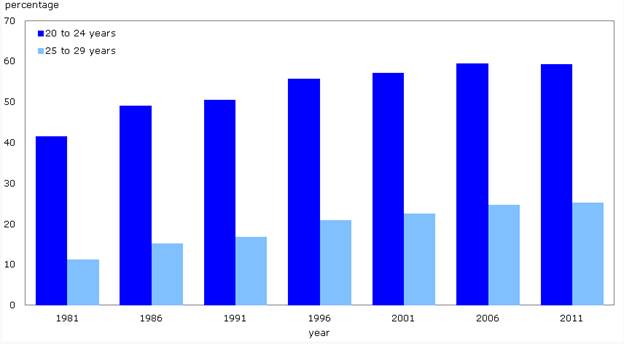Every once in awhile you see a news story saying something along the lines of “oh my, so many people in their 20s living with their failure to launch, my God, won’t somebody do something” followed usually by some freaking out about housing prices and – if we’re really lucky – something about humanities and working at Starbucks as well. Like this one from the CBC last week.
The excuse for that CBC piece was an American study which noted that 2014 was the first time that the most common type of dwelling for American 18-34 year olds was NOT under their own roof with a spouse/common-law partner. That of course has as much or more to do with changing patterns of university attendance and family formation as it does with patterns of leaving the parental house. Yes, the percentage living with their parents has risen from 20% to 32% over the last fifty-five (!) years (not exactly a fast-moving phenomenon), but the percentage living with a spouse/CLP has fallen from 62% to 32%. In fact, if you read a little further down, you realize that the percentage of 18-34 year olds living at home in the US today is…slightly lower than it was in 1940.
So, you know, maybe this isn’t such a big deal after all.
But still, people want to make it a story. For instance, in that CBC story, they note that “according to the most recent Statistics Canada census, 42.3 per cent of people in their twenties lived at home in 2011. That’s well up from previous generations, including 32.1 per cent in 1991 and 26.9 per cent in 1981.”
That’s technically true. But as with so many of the horror-stories about youth out there, most of the big changes happened before 1996, not recently. Here are the actual census numbers:
Percentage of Canadians aged 20-29 living with parents, 1981-2011.
In other words, this clearly isn’t a recent phenomenon. It’s not something caused by the great recession or housing prices. It’s something that’s happened quite gradually over time. What could it be?
First, note that the issue has a lot more to do with 20-24 year olds than it does with 25-29 year-olds. And what’s changed over the last 30 years among 20-24 year olds? Higher education, mainly. University participation rates have almost tripled in that time; colleges have increased as well. Call me crazy, but I think that increased rates of study – and hence decreased labour market participation – might have an effect on living arrangements.
Second, the youth demographic of this decade looks a lot different than the one of the 1980s. It’s a lot less white, for one thing. In 1981, visible minorities made up 4.7% of the Canadian population. If you look at the 15-24 age group in 2011, it’s about 25%, three quarters of which are of Asian descent. Asian cultures don’t really share the perspectives of those of British, French and North European descent about the need for kids to get out of the house early. It would be useful to look at the “living at home” data by ethnicity over time; it may well be that part of the change we are seeing is due to the changing ethnic make-up of the country rather than actual changes in behaviour.
Now, it’s hard to quantify the effects of increased study and changing demographics, so there might be some underlying economic changes to blame for the changing rates of leaving home. But I think those two factors offer enough common-sense explanation for this phenomenon that we should avoid making too big a deal over it.


 Tweet this post
Tweet this post

As a sociologist of the family, this story looks freakishly familiar. Another thing affecting that particular statistic is age at first marriage, and a general shift over time in the types of households that young adults live in. It’s not “with parents” or “with spouse” and hasn’t been for a very long time. There is also “with friends”, “alone”, and varying combinations. You have a good point about HE and the delay that causes to labour market participation. Increasing costs of HE probably also have an effect on whether people move away to go to university/college or live at home while doing so. The picture is complex.